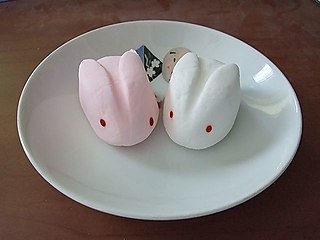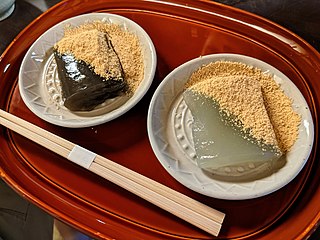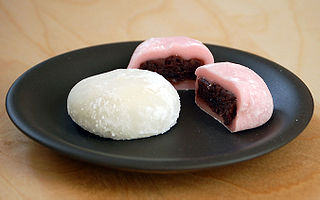
Dango is a Japanese dumpling made with regular rice flour and glutinous rice flour. They are usually made in round shapes, and three to five pieces are served on a skewer, which is called kushi-dango (串団子). The pieces are eaten with sugar, syrup, red bean paste, and other sweeteners. Generally, dango falls under the category of wagashi, and is often served with green tea. It is eaten year-round, but the different varieties are traditionally eaten in given seasons. Dango is sometimes compared with mochi, but is different in that mochi is generally made only with glutinous rice.

Mochi is a Japanese rice cake made of mochigome (もち米), a short-grain japonica glutinous rice, and sometimes other ingredients such as water, sugar, and cornstarch. The steamed rice is pounded into paste and molded into the desired shape. In Japan, it is traditionally made in a ceremony called mochitsuki. While eaten year-round, mochi is a traditional food for the Japanese New Year, and is commonly sold and eaten during that time.

Uirō, also known as uirō-mochi (外郎餅), is a traditional Japanese steamed cake made of glutinous rice flour and sugar. It is chewy, similar to mochi, and subtly sweet. Flavors include azuki bean paste, green tea (matcha), yuzu, strawberry and chestnut. Nagoya is particularly famous for its uirō, and there are other regional versions, notably in Yamaguchi and Odawara, although Odawara's uirō is better known as a medicine. It can be purchased in traditional Japanese confectionery shops throughout Japan.

Wagashi is a traditional Japanese confection made of mochi, anko, and fruit. Wagashi is typically made from plant-based ingredients with an emphasis on seasonality, and generally making use of cooking methods that pre-date Western influence in Japan. It is often served with green tea.

Yakimochi is grilled or broiled mochi or pounded rice cake. Traditionally, it is prepared using a small charcoal grill, but in modern times a gas grill can be used. During the time of the Autumn Moon, it is traditional to eat fresh yakimochi while sipping sake and enjoying the view of the full moon.

Noodle soup refers to a variety of soups with noodles and other ingredients served in a light broth. Noodle soup is a common dish across East Asia, Southeast Asia and the Himalayan states of South Asia. Various types of noodles are used, such as rice noodles, wheat noodles and egg noodles.

A rice cake may be any kind of food item made from rice that has been shaped, condensed, or otherwise combined into a single object. A wide variety of rice cakes exist in many different cultures in which rice is eaten. Common variations include cakes made with rice flour, those made from ground rice, and those made from whole grains of rice compressed together or combined with some other binding substance.

Soy protein is a protein that is isolated from soybean. It is made from soybean meal that has been dehulled and defatted. Dehulled and defatted soybeans are processed into three kinds of high protein commercial products: soy flour, concentrates, and isolates. Soy protein isolate has been used since 1959 in foods for its functional properties.

Miyagegashi refers to a sweet made with the purpose of selling it as a souvenir. As with most other Japanese souvenirs, the typical miyagegashi is a regional specialty and cannot be bought outside its specific geographic area. The making and selling of omiyagegashi is an important part of Japan's souvenir industry.

Warabimochi is a wagashi made from warabiko and covered or dipped in kinako. Kuromitsu syrup is sometimes poured on top before serving as an added sweetener.

Matcha (抹茶) is a finely ground powder of specially grown and processed green tea leaves that originated in China. Later, the characteristic green color of modern matcha was developed in Japan, where most matcha is produced today. In the 12th century at the latest, Chinese compressed tea, the raw material for matcha, was introduced to Japan. When the production of compressed tea was banned in China in 1391, matcha was abandoned in China but continued to develop in Japan thereafter.
A Kibi dango is a type of wagashi sweet or snack with an eponymous reference to Kibi-no-kuni, an old province roughly coincident with today's Okayama Prefecture. It is made by forming gyūhi, a sort of soft mochi, into flat round cakes. Glutinous rice, starch, syrup and sugar are the basic ingredients. It is manufactured by some fifteen confectioners based in Okayama City. While perhaps originally made from kibi, the modern recipe uses little or no millet, and substantively differs from kibi dango of yore, famous from the Japanese heroic folk tale of Momotarō or "Peach Boy"; nevertheless, "Kibi dango" continues to be represented as being the same as the folk hero Peach Boy's dumpling.

Daifukumochi (大福餅), or daifuku (大福), is a wagashi, a type of Japanese confection, consisting of a small round mochi stuffed with a sweet filling, most commonly anko, a sweetened red bean paste made from azuki beans. Daifuku is a popular wagashi in Japan and is often served with green tea.

There have been more than 300 limited-edition seasonal and regional flavors of Kit Kat chocolate bars produced in Japan since 2000, many exclusive to the country. Nestlé, which operates the Kit Kat brand in Japan, reports that the brand overtook Meiji Chocolate as the top-selling confectionery in Japan from 2012 to 2014. The company's marketing campaign, which partnered with Japan Post to sell the bar in 20,000 post offices, won an award in 2010. The campaign encouraged associations of the product's name with the coincidental cognate Kitto Katsu (きっと勝つ), translated as "You will surely win", and could be mailed as a good luck charm for students ahead of university exams.

Raindrop cake is a wagashi made of water and agar that resembles a large raindrop. It first became popular in Japan in 2014 and later gained international attention.

Butter mochi is a cake made from coconut milk, glutinous rice flour, and butter and is a popular dessert in Hawaiian cuisine.




















